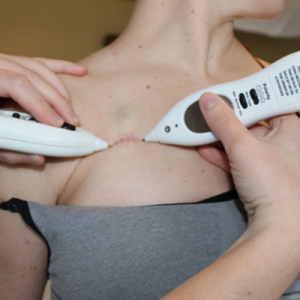The Harmful Effects Caused by Scars
1. Disruption of the Fascia
The fascia are layers of connective tissue underneath the skin that connect to all muscles and organs of the body. During surgery, fascial layers are injured by cutting, severing communication between them, and altering their structures. Also, a small injury can cause significant fascial straining throughout the body. In either case, the fascia develops “kinks” that ripple throughout the body and can cause chronic pain, spinal misalignments, and muscle weaknesses near or distant from the scar or trauma site.
2. Creation of Adhesions
Adhesions are bands of fibrous tissue that grow as scars close and heal. They act as internal “strait jackets”, reducing muscle and organ function and can cause pain.
3. Disruption of Energy Flow
Scars interfere with the energy flow throughout the body.
4. Upregulation of the Sympathetic Nervous System (SNS)
Physical stress on the body occurs from the presence of surgical and trauma scars and produces an overstimulation of the SNS. Prolonged upregulation of the SNS can overpower the parasympathetic nervous system (PNS) including the Vagus nerve. SNS stress is the “gas pedal” of the body and is only designed for short-term survival. Some of the signs and symptoms of prolonged upregulation of the SNS include:
-
-
- Decreased vagal nerve tone/function
- Decreased digestion
- Increased trigger point tenderness (inflamed muscle fibers)
- Decreased circulation
- Decreased immunity
- Increased muscle tone
- Increased blood pressure
-
The PNS is the “brake” of the body which slows us down and controls our digestion, detoxification, and immunologic balance. Eighty percent of this restoration response mediates through the Vagus nerve. The Vagus nerve is cranial (head) nerve #10 exiting from the right and left posterior sides of the skull and goes to various organs and structures in the chest, abdomen, head, and throat.
After the scars have been treated to reduce an upregulation of the SNS, then consideration should be given to microcurrent (small amounts of electrical stimulation) sessions applied to the auricular (ear) branches of the right and left Vagus nerves to improve vagal nerve tone/function. It is simple, non-invasive, and pain-free.
Examples of Common Scars from Surgical Procedures
- Head – Facelift
- Thorax (chest) – Open heart surgery; Breast augmentation
- Abdomen (stomach) – Tummy tuck; Hernia repair; Appendectomy
- Lower abdomen and groin – C-section; Hernia repair
- Spine – Laminectomy; Fusion
- Extremities (upper and lower) – Carpal tunnel surgery (nerve impingement at the wrist); Joint repair/replacement, e.g., shoulder, hip; knee, and ankle.
Scar Release Therapy and Traditional Treatment Methods
 Scar release therapy is a patented and scientifically published scar reduction technique that is simple, pain-free, and highly effective in reducing the negative influence of scars throughout the body. The therapy utilizes microcurrent to reduce dermal (skin) trauma, fascial restrictions, and adhesions – making the scar noticeably softer, with increased pliability and diminished size and physical appearance.
Scar release therapy is a patented and scientifically published scar reduction technique that is simple, pain-free, and highly effective in reducing the negative influence of scars throughout the body. The therapy utilizes microcurrent to reduce dermal (skin) trauma, fascial restrictions, and adhesions – making the scar noticeably softer, with increased pliability and diminished size and physical appearance.
Oftentimes, traditional treatment methods for surgical and trauma scars (steroid injections, the use of silicone sheets, oils, lotions, creams, and more surgery) are disappointing to both patients and surgeons.
Learn more about scar release therapy at https://www.dolphinmps.com/mps-scar-release-therapy/
